CONSTELLATION GUIDE
Last updated: 25 April 2001
CONSTELLATION GUIDE |
"GO TO"....BOOTES
(with discussions of objects in Corona Borealis, Coma Berenices and Serpens)
Entering the Domain of "THE HERDSMAN" With Your ETX and LX 90 Telescope
From: sherrodc@ipa.net (Clay Sherrod)
ABOUT THE CONSTELLATION "GO-TO" GUIDES!
In this third constellation guide installment, "GO TO BOOTES"- of our constellation study guides for ETX and LX 90 telescope users - we will explore the absolutely remarkable array of fine globular clusters, galaxies and doubles stars found in this group of constellations. As will all of our "GO TO GUIDES", it features a "start" with an easy GO TO to the bright star ARCTURUS, and then proceeds through the many fine examples of double and multiple stars, galaxies, clusters and interesting objects within reach of YOUR telescope! From bright starry globular clusters to beautifully-colored and complex multiple star systems, discussions along the way tell you what to expect from each telescope size and type. All objects will be discussed with exact descriptions of what the viewers of the ETX 60/70, ETX 90, ETX 125, and LX 90 should expect to see...and what to NOT expect to see!
The finest stellar and deep sky objects in these constellations will be featured....and - yes - there will be something for everyone and every telescope...Even naked eye and binoculars when appropriate!
Discussed are useful magnifications for EACH GO TO object, what type of night and conditions are needed to see certain details, double stars that can be resolved in each telescope model, and much, much more. It is your complete GUIDE for your deep sky observing pleasure and a very handy tool for use at your next star party!
Needless to say, it WILL put your AutoStar to work for you in a most efficient and enjoyable way!
I hope you will enjoy these comprehensive GUIDES to "Touring the Constellations" which will feature a NEW constellation about every two weeks, complete with diagrams, charts and illustrations. Please let us hear from you with summations of YOUR observations through these constellation tours!
----------------------------------
Introduction -
The constellation Bootes (pronounced "bo-o-tees" is marked by the remarkably beautiful and bright orange yellow star ARCTURUS, the "heralder of spring." But a discussion of the absolutely fascinating array of deep sky objects in Bootes would not be complete without including the many similar objects that rest just outside of its boundaries....in the smaller constellations of Corona Borealis, Coma Berenices and Serpens.

The click-on chart shown below can be downloaded to a file on your computer, resized in that file and printed as a complete star reference chart for these four constellations. Each of the reference numbers apply to the concise listing of objects found following.
It really takes some imagination with this group of stars to see the character imagined by the ancient Arabian skywatcher as a "bear herder" and in later cultures as merely a "herdsman of animals."
Perhaps not so difficult to at least "imagine" is the "Berenice's Hair," or Coma Berenices, the bright sprinkling of stars throughout this "mel 111" cluster of stars resembling the faint golden locks of hair immortalized in the heavens from Berenices II of Egypt the queen of Ptolemy III (246 B.C.). As Ptolemy had gone to a treacherous battle far away, his safe return was begged by Benenice is exchanged for her legendary hair locks which had been placed as sacrifice in the temple of Aphrodite. Only after the hair had vanished, did the ancient starwatchers of Egypt look up and realize that it had been magically transformed into the delicate spattering of stars in the constellation we now recognize as "Coma Berenices", a star group about 250 light years distant. There are about 35 stars that make up the main Coma group, the brightest of which are about 5th magnitude. Only in wide field binoculars on a dark night can the true beauty of this cluster be seen. but it is not the star groups that the constellation is known for astronomically.....it is the thousands of distant galaxies that are seen past those stars, literally filling large telescopic photographs with field after field of spiral and elliptical wonders.
On the opposite side (east) of Bootes is another small star pattern, the "northern crown" or Corona Borealis, a very pretty ringlet of stars marked clearly by the crown jewel, COR CAROLI.
----------------------------------
YOUR BOOTES / COMA BERENICES / CORONA BOREALIS CONCISE DIRECTORY
We will concentrate on 15 objects in THREE-CONSTELLATION (four if you count one object in "Serpens")tour; all are in reach of every telescope in our "ETX and LX family" yet each telescope will demonstrate uniquely different and challenging aspects of the objects. In addition to the 15 finest objects, there are literally hundreds of faint galaxies that are visible in most of the ETX and LX scopes as well as hundreds of double and multiple stars, stars of curious colors and motion. It is in this general area, and in the constellation of OPHIUCHUS (coming in an upcoming installment) that more galaxies can be viewed from Earth than at any other point in its orbit.
As will all of our GO TO TOUR GUIDES, I recommend good a good star atlas and/or chart which lists the finest objects constellation-by-constellation; if you cannot access any of these objects (or those that are not listed in this TOUR), you can access directly from coordinates - Right Ascension (RA) and Declination (DEC) of any known object via the AutoStar. You merely need to hold down your MODE key on the AutoStar for three (3) seconds and the RA and DEC coordinates appear for the telescope. Merely press "GO TO" and the cursor appears prompting you to enter the Right Ascension of the object if it is NOT listed among the objects in the AutoStar library; once the RA is entered, press "Enter" and the cursor once again prompts for the Declination coordinates (these coordinates for epoch 2000) are found in all good observing guides). Once those are entered, merely press "GO TO" once again and your ETX or LX 90 will slew to the position of the object!
The following constellation guide to objects at the end of this TOUR will describe all the details of each object and provide specifics as to visibility of that object in YOUR telescope model.
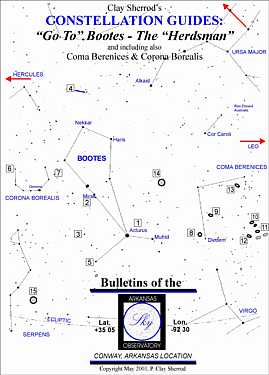
The special star chart here will get you started, as it demonstrates the relative positions of all objects in this "tour" to the conspicuous stars outlining the distinct figures of our three constellations of this TOUR.
Following is the complete 15-object list for your "GO TO TOUR" of Bootes, Coma Berenices, Corona Borealis and one object in Serpens; you may wish to find the majority of the objects from the AutoStar library (for example, you can merely pull up Messiers 5 or 3 by going to "Object/Deep Sky/Messier Object/M-5....enter....GO TO" or...if you want to experiment and be a "better AutoStar user", try entering the following coordinates (provided in the list directly following) as described under MODE above.
OBJECT 1:
bright star - ARCTURUS (alpha Bootis) - R.A. 14h 13'' / DEC + 19 27- Magnitude: -0.1
OBJECT 2:
beautiful double star - MIRAK (epsilon Bootis) - R.A. 14h 43' / DEC + 27 17 - Magnitudes: 2.4 & 5.0
OBJECT 3:
beautiful double star - XI Bootis - R.A. 14h 49' / DEC + 18 18 - Magnitudes: 4.8 & 6.8
OBJECT 4:
tough LX 90 test double! - 44 Bootis - R.A. 15h 02' / DEC + 47 51 - Magnitudes: 5.9 & 7 ? variable
OBJECT 5:
a great double for all! - Zeta Bootis - R.A. 14h 49' / + 19 18 - Magnitudes: 4.8 & 6.9
OBJECT 6:
double star test for ETX 90! - Sigma Cor. Bor - R.A. 16h 13' / DEC + 33 59 - Magnitudes: 5.7 & 6.7
OBJECT 7:
double star test for ETX 125! Eta Cor Bor. - R.A. 15h 21' / DEC + 30 28 - Magnitudes: 5.7 & 6.0
OBJECTS 8: (Coma Berenices)
2 globular clusters - Messier 53 (ngc5024) and ngc5053 - R.A. 13h 11' / DEC + 18 26 (super!!)
OBJECT 9: (Coma Berenices)
"black eye" galaxy - Messier 64 (ngc4826) - R.A. 12h 54' / DEC + 21 57 (a really cool object!)
OBJECT 10: (Coma Berenices)
galaxy - Messier 85 (ngc4382) - R.A. 12h 23' / DEC + 18 28
OBJECTS 11: (Coma Berenices)
3 galaxies - Messiers 98 (ngc4192), 99 (ngc4254), 100 (ngc4321) - R.A. 12h 11' / DEC + 15 11
OBJECT 12: (Coma Berenices)
galaxy - Messier 88 (ngc4501) - R.A. 12h 30' / DEC + 14 42
OBJECT 13: (Coma Berenices)
the famous "needle" edge-on galaxy - ngc4565 - R.A. 12h 34' / DEC + 26 16 ( a must-see!!)
OBJECT 14: (Canes Venatici)
globular - Messier 3 (ngc5272) - R.A. 13h 40' / +28 38 (this is the one you don't want to miss!)
OBJECT 15: (Serpens)
wonderful globular - Messier 5 (ngc5904) - R.A. 15h 16' / DEC + 02 16 - THE FINEST GLOBULAR!
--------------------------------------------
A VISUAL GUIDE TO OUR OBJECTS IN THIS CONSTELLATION SELECTION -
Object 1 - Bright Star Arcturus (Alpha Bootis)
Unknown to most, this is the brightest star NORTH of the celestial equator, shining a beautiful deep yellowish red color, even when low on the horizon. To the ancient people of northern hemispheres, the first rising of Arcturus seen at dusk, just when enough darkness had fallen, signified the "heralder of springtime."
Even more fame for this star (Arabic for "the Bear's Guardian") came recently during the opening of the World's Fair in 1933 to signal the new era of technology (boy, did they predict that one right!). To open this exposition in Chicago, Arcturus' light was telescopically focused to a photoelectric cell, thus throwing on the power via its switch to the entire gala affair! At 40 light years distant, the very light that opened the fair had left Arcturus in 1893 in the year of the last previous such fair held in that city!
At magnitude -0.1, Arcturus is one of the few stars that can be found with your GO TO computer during daytime! After your eyes get accustomed to the bright background light of the finderscope, it is clearly visible when nearly overhead and far away from the sun's glare. Arcturus is huge - about 20 million miles across - and well over 100 times more luminous than our sun.
Object 2 - Bright Double Star MIRAK (epsilon Bootis)
This double star - at a separation of 2.9" arc and magnitudes of 2.4 and 5.0 - would be thought to be relatively "easy" double star to split with nearly all of our telescopes. However, this one is a tough, tough test for the ETX 90 and not at all resolvable with the 60 & 70. With the ETX 125, the star is more easily resolved at very high power on a good night, but it is still not a simple task. With this scope and the LX 90, look for a wonderful color contrast: yellow-orange for the brighter star and blue for the fainter one. Much magnification is required to see both the color and the clear separation of these two stars.
Object 3 - Double Star XI Bootis
This star is one of the finest doubles for all telescopes. At 7" arc separation, you can clearly see both components of this very reddish pair of stars. With a combined magnitude of about 4th, they are an easy target and a nice "show" object. With an orbit of nearly 150 years, this is about the widest you will ever see these two stars separated. Look for the fainter star just a bit NNW of the brighter "parent" star. Medium power should be used with the ETX 60 & 70, about 80x to 100x in all other scopes is ideal.
Object 4 - An acid test for your ETX 125 and LX 90 - Double Star 44 Bootis
So you think you're scope is perfectly collimated....great optics....good eyesight....running with the big dogs. So aim that ETX 125 or LX 90 light bucket over to 44 Bootis and let's see what you can do! The main star of this double is almost exactly like our sun....same size, luminosity, color. However, at a distance of ONLY 750,000 miles is another star orbiting that sun. This is the time to attempt to split this one, folks, having just now reached it APHELION to the east of the primary star, the little secondary star is a full 3" arc DUE NE of the main star. But don't let that distance fool you...it is a tough one. The second star is a bit variable and erupts from time to time. Note that the apparent separation is again closing between these two stars; in 2040, they will once again only be about 0.3" arc apart.....so see it while you can!
Object 5 - Great double star Zeta Bootis - A super double star test for the ETX 90 and ETX 125
This is a gorgeous double star, with components of magnitude 4.4 and 4.8 and a separation of about 6" arc. Because of their similarities in magnitude, this is a relatively tough star to split with the ETX 90, but is easy with the ETX 125 and high power. On a very steady night, however, the -90 should open these up. Although many books have reported that it is only resolvable with a 4" telescope or larger, I have clearly split this star with a Questar 3.5" but have unfortunately not had an opportunity to try with the ETX 90....results and reports on this, please!
Object 6 - Double Star in Corona Borealis - Sigma Cor Bor
At a relatively bright magnitude 5.4 and the wide separation of about 8" arc, this is a very pretty and "easy" double star for all of our telescopes. Medium powers (about 15x per inch) are recommended for the entire range of aperture here. Both are almost equal colors. An added bonus for those with the LX 90....look about only 12' arc to the SOUTHWEST from the main star....here you will see a very red star LTT 14836, a very classic red dwarf star that, even with its faintness, is unmistakably red in color.
Object 7 - Double Star for ETX 60/ 70 Test - Beautiful object for all!
This star, ALULA AUSTRALIS, is actually in the constellation of Ursa Major (one of its back paws) and was featured in the previous constellation TOUR; if you missed it, check it out while you are here. This is a fine double star that is challenging for the ETX 60 and 70 at medium power and a beautiful sight in all telescopes.
Object 8 - Nice ACID TEST DOUBLE STAR for the LX 90 - Eta Corona Borealis
Although sometimes wide enough in its short 42-year period to resolve in the ETX 90 and ETX 125, right now the companion to Eta Cor. Bor. is due east from the main star (mag. 5.7) only by about 0.4" arc, a true acid test for an 8" scope. You MUST use very high magnification and only attempt on the very darkest and most still nights to resolve this star....otherwise you will be disappointed.
Object 9 - Galaxy - The "Black Eye Galaxy" Messier 64 (Coma Berenices)
This one is a must-see in the ETX 90 and larger telescopes. However, ETX 60 & 70 users, it is a great object for you as well, one of the brightest of all the galaxies visible in our scopes! At a full 8th magnitude and measuring 7.5' x 4' diameter, this is an incredible object. In the smaller scopes it appears as a very nicely compact oval; on a very dark night with about 100x, you might glimpse a little hint of the dark dust lane for which this galaxy is famous. It clearly bisects the bright hub of the galaxy, separating what you will see of this oval into about a 1/3 portion below and 2/3 above the dark lane. This effect is particularly pronounced and visible in the ETX 125 and LX 90 scopes, and can be glimpsed on very dark nights with higher magnifications with the smaller telescopes. High powers are recommended for the best viewing go M-64. The nature of this interesting "black eye" is a huge lane of dark, light-obscuring dust in the galaxy. At a whopping 44 million light years distant, this object is one of the finest of all deep sky objects for smaller telescopes.
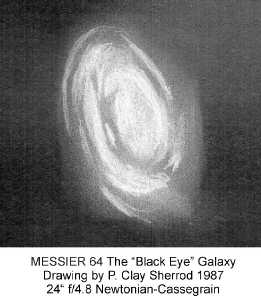
Object 10 - Galaxy - Messier 85
At only magnitude 10.5 to the eye, this is a difficult object (but can be seen under very dark conditions) for the ETX 60, 70 and 90; it is featureless, even with medium-high power and very dark skies in both the ETX 125 and LX 90, appearing as a uniformly-illuminated elongated oval with no distinct markings within. However, the larger scopes CAN see a distinct brightening as you progress toward the center portion of this oval. Those with the LX 90 telescope can probably spot another spiral galaxy (only about magnitude 10.7), ngc 4394 about 8' arc to the east of M-85, easily in the same field of view at medium magnification.
Objects 11 - Galaxy Group in Coma Berenices: Messiers 98, 99, 100
These three galaxies form a very large triangle very near to one-another in the sky; however, except with very low magnifications and a wide field of view, they likely will NOT be seen in the same field. All are faint magnitude 10.3 to 10.7 and thus out of the reach of the ETX 60....perhaps they can be seen with medium power with the ETX 70 and ETX 90 but ONLY under the most favorable conditions. Even with the LX 90's 8" aperture, expect nothing but faint elongated patches of light, and very difficult at that. Use your GO TO under "messier object" to locate each of the individually. Of the three, M-98's shape is conspicuous as it is a near-edge-on spiral, very large (8' long) and appears like a pencil of light under dark sky conditions. M-99 has a very concentrated core or nucleus which can just barely be discerned in the ETX 90.
Object 12 - Galaxy - Messier 88
At magnitude 10.5, this galaxy is still a good object for all of our telescopes; it is one of the brightest of the large concentration of galaxies in this general area, and will handle magnification very well. Using averted vision with the ETX 125 and LX 90, some faint wispy detail might be glimpsed in this very white and otherwise uniform image. It appears fairly large and round in all scopes, and should be observed with about 20x per inch aperture for best results.
Object 13 - Fantastic Edge-On Galaxy - NGC4565
This is the one you've seen in numerous photographs, the "needle" of light, the most famous of all edge-on galaxies. I have clearly seen the central dark dust streak for almost the entire 12' arc length of this thin streak of light in an 8" Schmidt on numerous times; under very dark conditions, the ETX 125 shows it clearly against the enlarged "hub" of the galaxy's center. For all scopes, this is an amazing sight, appearing as a thin sliver of light that will fill a medium-power eyepiece of the ETX 90! In very dark skies, this is a remarkable object and its shape is plainly obvious even at low power. Its concentrated light makes for an almost-three-dimensional. On the ETX 90, 125 and the LX 90, if you are fortunate enough to have either the 13.8mm SWA or the 14mm UWA eyepieces, this galaxy provides an incredible sight and an unforgettable image for you.
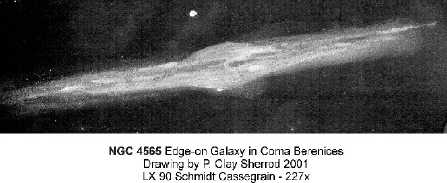
Object 14 - Globular Cluster - Messier 3 (in Canes Venatici)
Now, we're getting into some remarkably memorable images! Messier 3 will be partially resolved even in the ETX 90, and will show some "granulation" of stars in the ETX 60 and 70; however, in the ETX 125 the stars really begin to come out at about 160x; in the LX 90 with the 8.8mm UWA, this globular is magnificent and even the star COLORS are evident on dark nights. Globular clusters "take" power very well; I have found that about 230x is the limit for the LX 90; 160x for the ETX 125, and 120x for the ETX 90. A power of around 75-80x will do the best job on these clusters with the ETX 60 and 70. The stars in M-3 are numbering in the 100's of thousands, and from earth all are 11th magnitude and fainter. Hundreds of these can be glimpsed on a very dark night at 160x with the ETX 125, and many scores of peripheral stars (outlying) can be seen with the ETX 90. Stars all the way into the center, perhaps thousands, can be glimpsed like stardust with the LX 90. In ALL scopes look for "streams" or "arms" of stars that appear to radiate outward in noticeable stings from the center. This effect can be seen even if you do not fully resolve the cluster. Below is
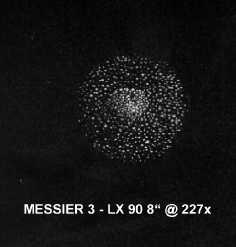
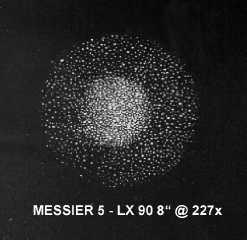
Object 15 - Large Globular Cluster in Serpens - Messier 5
Clearly the overall finest globular star cluster of the skies; not appearing quite as large as well-known Messier 13 in Hercules because it is more distant, this cluster is one of the showcase deep sky objects. In small and medium amateur telescopes you will see a brighter image of stars uniformly across this globular than with the sparsely (by comparison) M-13. The stars appear to outnumber those of M-13 as well, and range from about 11th magnitude to 15th; like M-5, the ETX 90 will show peripheral stars along the fringes of this beautiful site with a "granulated" appearing and very bright core. Hundreds of stars across the entire object will be seen on a dark night with the ETX 125, and the globular is truly spectacular in the LX 90, although I have yet to see distinguishable star colors in this one as I can clearly seen in M-5 and M-13.
Even good binoculars (and your finderscopes) will show M-5 as a fuzzy ball in the sky and the ETX 60 and 70 give a spectacular low-power panoramic view of this object against a beautiful background of stars. For your information, M-5 is one of the oldest objects known in our galaxy, perhaps dating back 15 BILLION YEARS.
--------------------------------
WANDERING ABOUT....YOUR NEW "USER OBJECT" FOR BOOTES
This brief GO TO Tour of Bootes and nearby constellations has revealed their most interesting objects. But please do not stop here. Go ahead and locate many of the hundreds of other ngc galaxies that are present in this constellation.....there are several more interesting double and multiple stars that are within the reach of your telescope. In addition, use this opportunity to actually LOAD ANOTHER USER OBJECT onto your AutoStar!
HOW ABOUT THIS FOR A SHOWCASE 'USER OBJECT?' We all know how to find "celestial north" or the South Celestial Pole here on earth. We rather take it for granted. Those poles are the location in space toward which our EARTH's axis of rotation points.
But what of the Milky Way Galaxy in which our Earth and its Sun are located? It spins on its axis, just like all galaxies.....where is ITS "north galactic pole" pointing? Here's YOUR chance to actually aim your ETX or LX 90 telescope at the GALAXY'S NORTH CELESTIAL POLE! This is the point in deep space toward which our 250 billion-sun Milky Way galaxy's axis of rotation is pointing....just like Earth's north axis pointing toward Polaris! It just so happens that the "NGP" is located just inside of the constellation of Coma Berenices!
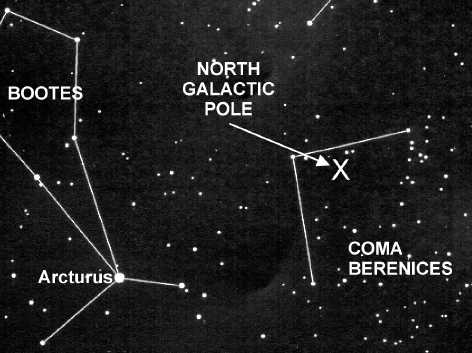
On AutoStar, go to: "Select/Object [enter] and scroll down to "user object" [enter]. Now enter these coordinates: R.A. 12h 50' / DEC +27 52' ; under "description" write something creative like "dead center" or something. You will now have as your THIRD TOUR USER OBJECT the North Galactic Pole programmed to properly hold your guest in awe over.
Next Constellation "GO TO TOUR" Installment: OPHIUCHUS and its wealth of outstanding globular clusters, galaxies and other objects!
Good observing and explorations of the wonderful world of deep space!
P. Clay Sherrod
Arkansas Sky Observatory
Conway / Petit Jean Mountain
Arkansas
Return to the top of this page.
Go back to the Observational Guides & References page.
Go back to my ETX Home Page.